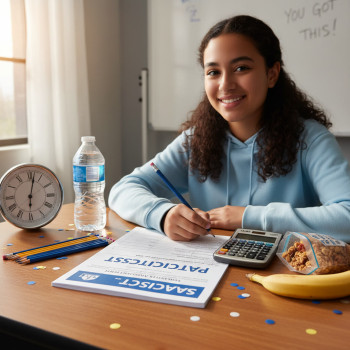Why confidence matters more than you think
Walk into a practice test knowing you’ve prepared, and everything feels a little crisper: your timing, your attention to detail, your ability to bounce back after a tough question. That subtle boost? That’s confidence — and it’s not a vague personality trait reserved for the naturally poised. Confidence is a skill you can grow, measure, and apply to improve SAT practice scores dramatically.
In this post I’ll guide you through what confidence actually means in SAT prep, the science behind why it improves practice scores, concrete ways to build it, and how to create a weekly practice plan that turns steady practice into measurable score gains. You’ll also see how Sparkl’s personalized tutoring — 1-on-1 guidance, tailored study plans, expert tutors, and AI-driven insights — can fit naturally into this process to accelerate progress when you need a boost.
What confidence really is (and what it isn’t)
Confidence isn’t cockiness or pretending you know everything. For SAT prep, confidence is a reliable blend of two things:
- Competence — the concrete knowledge and skills you’ve practiced (vocabulary, grammar rules, algebra techniques, timing strategies).
- Trust in your process — the conviction that your study routine, test-day plan, and recovery strategy will carry you through tough moments.
Put simply: competence answers the “Can I do it?” question. Trust answers “Will I do it when it matters?” Both are trainable.
The science: how confidence improves practice-test performance
There are a few overlapping mechanisms where confidence influences measurable outcomes on practice SATs and on the actual exam.
1. Cognitive bandwidth and working memory
Anxiety steals attention. When you’re worried about failing, your working memory — the mental scratchpad you use for multi-step problems and complex reasoning — gets smaller. Confidence frees up that space. Instead of spending cognitive resources on “What if I mess up?”, you can focus on strategies, comprehension, and calculation.
2. Risk management and time allocation
Confident students make clearer decisions about which questions to attempt, skip, or flag. That means better pacing: spending the right amount of time on high-value questions and avoiding time-wasting fixations on low-yield traps.
3. Resilience after mistakes
Practice tests are full of learning opportunities — often disguised as discouragement. Students with healthy confidence recover faster from errors, preventing one mistake from cascading into several misses. The result: steadier scores across the section instead of wild swings.
4. Motivated, consistent practice
Confidence and motivation feed each other. Small wins (like shaving five minutes off a section or mastering a grammar rule) build confidence, which makes you more likely to stick to practice. Consistency compounds; steady practice beats last-minute cramming.
How confidence shows up in real SAT practice
Here are some concrete signs that confidence is improving your practice-test performance:
- You start finishing sections with time to spare and fewer random guesses.
- When you see a question you don’t immediately know, you calmly break it down rather than panicking.
- Your practice score trend is upward or stabilizing after targeted study sessions.
- You analyze errors objectively (“What went wrong? What will I change?”) instead of taking mistakes personally.
Practical strategies to build SAT confidence
Below are research-backed, practice-ready habits you can adopt. You don’t need to change everything at once; pick two or three and turn them into routines.
1. Master the fundamentals with deliberate practice
Deliberate practice is focused, goal-oriented, and feedback-driven. Rather than doing dozens of untargeted questions, isolate weak areas and drill deliberately. For example:
- If sentence structure trips you up, spend two sessions on comma rules and parallelism, then mix in timed practice.
- For algebra weaknesses, do targeted problems until you can solve them without hesitation, then add timed sets.
Seeing steady progress on targeted skills builds competence, the foundation of confidence.
2. Simulate real testing conditions regularly
Confidence grows in environments you know. Take full-length practice tests under realistic timing and breaks. That familiarity reduces novelty on test day and makes you less likely to be derailed by the environment, timing, or test format.
3. Use an error log to convert mistakes into wins
After each practice set, record every missed question with four quick notes: topic, error type (careless, concept, timing), the fix, and a targeted follow-up question. Review the log weekly. This turns mistakes from demoralizing failures into a reliable roadmap for improvement.
4. Build small rituals to anchor calm
Pre-test rituals — a short warm-up passage, a breathing exercise, or a quick review of high-yield formulas — lower stress. Rituals work because they shift attention from worrying to doing. Over time, the ritual itself elicits calm.
5. Use mixed timed practice instead of only untimed review
Untimed review is essential for learning, but timed mixed practice teaches you to apply knowledge under pressure. Alternate: learn a concept untimed, then test it in a timed set. The alternation trains both competence and pacing.
How coaching amplifies confidence — where Sparkl fits
Personalized tutoring can accelerate the journey from basic competence to confident performance. Consider how tailored 1-on-1 guidance helps:
- Expert tutors diagnose the highest-leverage weaknesses faster than guessing on your own.
- Tailored study plans focus your time on the 20% of skills that yield 80% of score improvement.
- Regular feedback and encouragement build trust in your process — a key ingredient of confidence.
Sparkl’s personalized tutoring combines these elements — expert tutors, customized plans, and AI-driven insights — so you’re not practicing in a vacuum. You get targeted drills, progress-tracking that shows real movement, and a coach to help manage setbacks. That combination often shortens the path from inconsistent practice to steady, confident performance.
Sample 8-week confidence-building SAT practice plan
The following plan balances skill work, timed practice, and recovery. It assumes 8 weeks of focused prep with 6–10 hours per week. Adjust the hours to match your schedule.
| Week | Main focus | Weekly structure | Confidence goal |
|---|---|---|---|
| 1 | Diagnostic & fundamentals |
|
Understand baseline; create an error log |
| 2–3 | Targeted skill building |
|
Notice consistency on drilled topics |
| 4–5 | Timed application |
|
Execute strategies under time pressure |
| 6 | Refine & target weak spots |
|
Reduce careless errors; build resilience |
| 7 | Full dress rehearsals |
|
Simulate test day experience |
| 8 | Taper & confidence maintenance |
|
Arrive calm, focused, and ready |
Why this plan builds confidence
It alternates learning and pressure. Weeks of skill-building create competence; weeks of timed practice create trust in your process. The final taper prevents burnout and protects confidence on test day.
Everyday habits that sustain confidence
Confidence is fragile if you overload yourself. Add these small, sustainable habits:
- Sleep: Aim for 7–9 hours before heavy practice and test day. Sleep consolidates memory and sharpens focus.
- Nutrition: Balanced meals, steady hydration, and a light snack before study/test help maintain energy and concentration.
- Micro-reviews: Two 10-minute sessions a day reviewing formulas or grammar rules beats a single 2-hour cram.
- Reflection: Spend 10 minutes after each practice logging what worked and one action to change next time.
Common confidence traps and how to break them
Even motivated students fall into traps that undermine confidence. Here are the usual suspects and practical fixes.
Trap: Over-focusing on one bad practice test
Fix: Treat each test as one data point. Look for patterns across several tests. Use your error log to see trends and focus your adjustments there.
Trap: Comparing your score to someone else’s
Fix: Comparison steals confidence. Compare your current performance to your past self. Track week-to-week improvements and celebrate progress metrics like fewer careless errors or improved timing.
Trap: Perfectionism — expecting a flawless test immediately
Fix: Embrace incremental gains. Aim to reduce mistakes by a measurable amount each week (e.g., two fewer grammar errors, five fewer calculator mistakes). Small wins compound into strong scores.
How to measure confidence (and why it matters)
Confidence isn’t just a feeling; you can measure it with proxies. Track the following:
- Practice score trends across 4–6 tests.
- Time remaining on sections when completed.
- Rate of careless vs. concept errors in your error log.
- Emotional response scale: Before each practice, rate your anxiety 1–10. Over time, you should see a drop for similar tasks.
Using numerical measures turns an abstract idea into actionable feedback. Sparkl’s AI-driven insights can help visualize these trends and highlight the highest-impact adjustments so you’re not guessing about what to change next.
Real-world example: Emma’s 100-point turnaround
Emma started with a realistic problem: strong math fundamentals but chronic timing problems and test-day anxiety. Her plan focused on two changes: timed mixed practice to master pacing and an error log to stop repeating careless mistakes.
After six weeks of targeted work — two full-length practice tests per week, daily 20-minute drills, and weekly coaching check-ins — Emma’s practice score rose by 90–110 points. But more importantly, she reported feeling calm during tests and was able to execute a pacing plan that left her time for review. The combination of competence and trust in her own process created real score gains.
That’s the kind of progress students often see when focused study meets consistent coaching. Sparkl’s personalized tutoring provided Emma with targeted homework, expert feedback, and a coach who helped rebuild her relationship with mistakes — turning them into the fuel for confidence.
Quick, actionable checklist to boost confidence before your next practice test
- Take a short, timed warm-up passage to get into testing rhythm.
- Use your error log to review one weak concept for 10 minutes.
- Practice two breathing cycles (4–4–4) before you start to center attention.
- Set a simple pacing rule for the section (e.g., average time per question) and stick to it.
- After the test, log one thing you controlled well and one thing to improve.
Parting thought: confidence is practiceable
Confidence isn’t magic. It’s the predictable result of deliberate skills practice, realistic simulation, meaningful feedback, and small rituals that lower anxiety. If you invest in building competence and trust in your process, your practice scores will follow.
And remember: you don’t have to do it alone. A good tutor or structured program can shorten your path dramatically. Sparkl’s personalized tutoring—delivering 1-on-1 guidance, tailored study plans, expert tutors, and AI-driven insights—can be the reliable partner that helps you convert steady work into steady confidence and measurable score improvement.


Ready to get started?
Pick two strategies from this post and try them for two weeks: one skill-building habit (like an error log or targeted drills) and one confidence habit (like simulated tests or a pre-test ritual). Measure the difference in your practice scores and your sense of ease while testing. Small, consistent steps will get you farther than dramatic last-minute efforts.
When you’re ready for tailored guidance, consider working with an expert coach to create a plan that matches your starting point, schedule, and goals. Confidence is a skill — and with the right approach, it can become one of your strongest test-taking tools.
Final encouragement
Every student’s path is different, and every improvement counts. Trust the process: practice deliberately, reflect honestly, and build little habits that support calm. Over time, you’ll find that the practice scores you once hoped for become the scores you expect. That shift — from hope to expectation — is the real power of confidence.













No Comments
Leave a comment Cancel